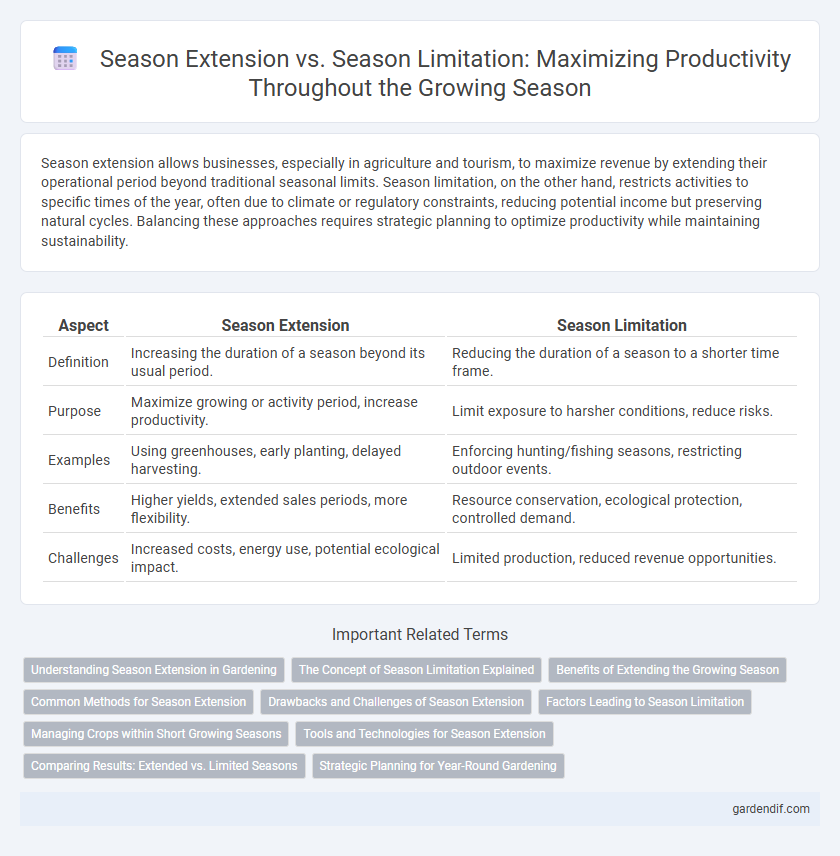
Season extension vs Season limitation Illustration
Season extension allows businesses, especially in agriculture and tourism, to maximize revenue by extending their operational period beyond traditional seasonal limits. Season limitation, on the other hand, restricts activities to specific times of the year, often due to climate or regulatory constraints, reducing potential income but preserving natural cycles. Balancing these approaches requires strategic planning to optimize productivity while maintaining sustainability.
Table of Comparison
| Aspect | Season Extension | Season Limitation |
|---|---|---|
| Definition | Increasing the duration of a season beyond its usual period. | Reducing the duration of a season to a shorter time frame. |
| Purpose | Maximize growing or activity period, increase productivity. | Limit exposure to harsher conditions, reduce risks. |
| Examples | Using greenhouses, early planting, delayed harvesting. | Enforcing hunting/fishing seasons, restricting outdoor events. |
| Benefits | Higher yields, extended sales periods, more flexibility. | Resource conservation, ecological protection, controlled demand. |
| Challenges | Increased costs, energy use, potential ecological impact. | Limited production, reduced revenue opportunities. |
Understanding Season Extension in Gardening
Season extension in gardening involves techniques like using cold frames, row covers, and greenhouses to prolong the growing period beyond traditional frost dates. By maintaining optimal temperature and humidity, gardeners can grow crops earlier in spring and later into fall, increasing yield and variety. Season limitation occurs when environmental factors like frost, daylight, and temperature restrict plant growth to a shorter window.
The Concept of Season Limitation Explained
Season limitation refers to the defined period within a year when specific activities, such as agricultural planting or retail promotions, are permitted or effective, based on climatic, biological, or market factors. Unlike season extension, which seeks to prolong the productive or favorable period through technological or logistical means, season limitation enforces natural or regulatory boundaries that restrict timing to optimize outcomes and resource use. Understanding season limitation is crucial for industries like farming, tourism, and fashion, where aligning operations with seasonal windows maximizes yield, quality, and consumer engagement.
Benefits of Extending the Growing Season
Extending the growing season increases crop yields by allowing plants to mature for a longer period, enhancing food production efficiency. It reduces vulnerability to adverse weather, minimizing crop losses caused by early frosts or unexpected cold snaps. Longer seasons also enable multiple planting cycles, boosting overall farm profitability and sustainability.
Common Methods for Season Extension
Common methods for season extension include using high tunnels, row covers, and greenhouses to create controlled microclimates that protect crops from frost and temperature extremes. These techniques enhance plant growth by maintaining optimal humidity and soil temperature, allowing for earlier planting or later harvesting. Utilizing windbreaks and mulching also helps reduce cold stress and conserve soil moisture, effectively prolonging the growing season.
Drawbacks and Challenges of Season Extension
Season extension often leads to increased operational costs due to the need for artificial heating, lighting, and protection methods that can strain financial resources. Prolonged exposure to non-ideal climatic conditions raises the risk of pest infestations and disease outbreaks, complicating crop management. Challenges also include fluctuating market demand and reduced crop quality, which can negatively affect profitability and sustainability.
Factors Leading to Season Limitation
Season limitations often arise from critical factors such as adverse climatic conditions, including extreme temperatures and unpredictable weather patterns that impede agricultural productivity or outdoor activities. Limited natural resources, such as water scarcity during dry periods, further constrain the duration of viable seasons for farming or tourism. Additionally, regulatory measures and ecological considerations aimed at preserving biodiversity can impose strict boundaries on seasonal operations.
Managing Crops within Short Growing Seasons
Managing crops within short growing seasons requires strategic season extension techniques such as using high tunnels, row covers, and plastic mulches to increase crop yield and quality. Season limitation poses challenges due to temperature constraints and frost risk, necessitating selection of fast-maturing crop varieties and optimized planting schedules. Effective season management balances crop physiological needs with environmental factors to maximize productivity in limited time frames.
Tools and Technologies for Season Extension
Advanced tools and technologies for season extension include high tunnels, row covers, and smart climate control systems, which optimize growing conditions beyond traditional seasonal limits. LED grow lights and automated irrigation systems enhance plant growth during colder months by providing consistent light and moisture levels. These technologies collectively increase crop yield and quality by mitigating environmental constraints associated with season limitation.
Comparing Results: Extended vs. Limited Seasons
Extended seasons increase agricultural yields by allowing multiple crop cycles, boosting overall production and profitability. Limited seasons restrict growth periods, often resulting in lower yields but can improve crop quality by reducing exposure to pests and extreme weather. Data shows extended seasons enhance food security in regions with stable climates, while limited seasons may suit areas prone to environmental stress, highlighting the importance of selecting strategies based on regional conditions.
Strategic Planning for Year-Round Gardening
Season extension techniques such as using high tunnels, cold frames, and row covers enable gardeners to strategically plan for year-round cultivation by protecting crops from frost and temperature extremes. Conversely, season limitation imposed by climate and daylight hours requires selecting crop varieties with appropriate maturity rates and implementing succession planting schedules to maximize productivity. Integrating controlled environment agriculture and careful scheduling enhances continuous harvests, optimizing both resource use and garden output throughout the year.
Season extension vs Season limitation Infographic

 gardendif.com
gardendif.com